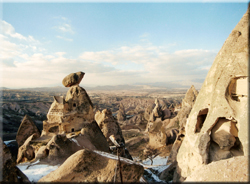Small Cave Hotel in the heart of Cappadocia
ASMALI CAVE HOUSE
Uçhisar Village
Situated just 7 km from Nevşehir, Uçhisar marks one corner of a virtual triangle with Ortahisar and Ürgüp, the heart of Cappadocia.
Looking at Uçhisar from a distance, it appears to be one huge rock, broken and riddled with holes. Coming closer you see more and more houses built all around and into the stone. Narrow streets are squeezed in between the structures, along with mosques, fountains and yards. This is the village of Uçhisar with its fortress, the kale, situated at the highest point in the region. Once entirely covered by tuff, today the rock of the kale is riddled with holes caused by erosion. Wind and rain have shaped the stone into conical form and divided the peak into two.


A journey to the past
See old photos from Uçhisar in Cappadocia
Collected by Murtaza Boğazlı,
Mehmet Teke, Mehmet Cehrili
Fairy Tales and Legends
Who has not sat in front of their grandparents, quietly listening to their stories or tales of times gone by?
Here you find a collection of Fairy Tales and Legends passed on by word of mouth, childhood memories of the eldest of Uchisar in Cappadocia.
Uçhisar Castle
The view from the top of this extraordinary rock, with its height of 1350 meters above sea level is unforgettable as it offers a panoramic view of all of Cappadocia, including the magnificent Mount Erciyes.
It is obvious from this location that Uçhisar was once an important strategic point. From the 5th century on during the Byzantine Period, this place was used as natural fortress for defense against Persian invaders. As time went on, more and more caves were hollowed out of the soft tuff as the people sought refuge here. In the rock-hewn churches they prayed for their lives.
 As the small village near the castle grew in population, the inhabitants needed additional forms of retreat. Gradually more and more accommodations were created for the families as well as the animals, resulting in real landscaped interiors with stores and stables. In the case of an imminent attack, the people of the village would wait in the fortress until the danger was over. The gates, entrances and pathways of the kale were doubly and triply secured by heavy, round stones, which were rolled in front of the openings. These blocks had been cut directly out of the wall, and once closed from the inside, there was no chance for the intruders to force their way into the rooms (link underground cities). Despite all precautions, however, the kale would ultimately fall to the enemy, proving that even the strongest defense may in time prove vulnerable.
As the small village near the castle grew in population, the inhabitants needed additional forms of retreat. Gradually more and more accommodations were created for the families as well as the animals, resulting in real landscaped interiors with stores and stables. In the case of an imminent attack, the people of the village would wait in the fortress until the danger was over. The gates, entrances and pathways of the kale were doubly and triply secured by heavy, round stones, which were rolled in front of the openings. These blocks had been cut directly out of the wall, and once closed from the inside, there was no chance for the intruders to force their way into the rooms (link underground cities). Despite all precautions, however, the kale would ultimately fall to the enemy, proving that even the strongest defense may in time prove vulnerable.
The first changes
After the Byzantine Empire began to decline in Anatolia it was summarily defeated by the Turkish Seljuks in the 11th century. The kale then fell into the hands of the Seljuks who proved to be enlightened rulers.  The villagers stayed in their homes and accepted the new dynasty. Again, more houses were erected in front of the dwellings in the rock. Uçhisar continued to remain intact under later principalities and also under the rule of the far flung and powerful Ottoman Empire.
The villagers stayed in their homes and accepted the new dynasty. Again, more houses were erected in front of the dwellings in the rock. Uçhisar continued to remain intact under later principalities and also under the rule of the far flung and powerful Ottoman Empire.
Uçhisar remained unchanged when the Turkish Republic declared by Mustafa Kemal Atatürk in 1923 as well.
Then, in the 1950’s, it was time for the last inhabitants to leave the kale. The families were forced out of the homes they had occupied for centuries, not by the laws of men or vicissitudes of war, but rather by the acts of nature. The study process of erosion throughout the centuries had left the fortress weakened and dangerous.
Inside the fortress, huge dwellings divided by arches had been directly carved from the stone; there was even an impressive Mansion. Unfortunately, this building was destroyed in the early sixties when an enormous part of the kale collapsed and tons of stone fell down onto nearby houses. Since that catastrophe, the inner structure of the castle has suffered from exposure to wind and rain.
Where soldiers once fought for their convictions, people found their homes and pigeons later built their nests, tourists now climb up and down, squeezing through the holes, rooms and passage-ways. Still, the legends surrounding the rock will not be forgotten. In the evening when all is quiet and the setting sun throws its last golden rays over the village, keep that final picture of the kale in your mind and close your eyes, then you can imagine.
Still, the legends surrounding the rock will not be forgotten. In the evening when all is quiet and the setting sun throws its last golden rays over the village, keep that final picture of the kale in your mind and close your eyes, then you can imagine.

